Exploring the Depths of Dark Cabinets: A Comprehensive Guide
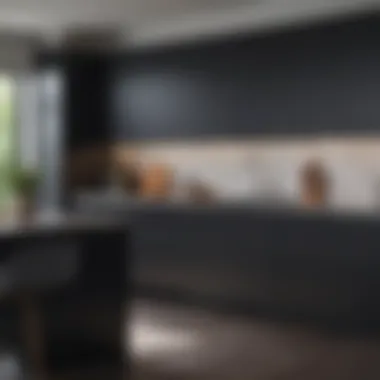
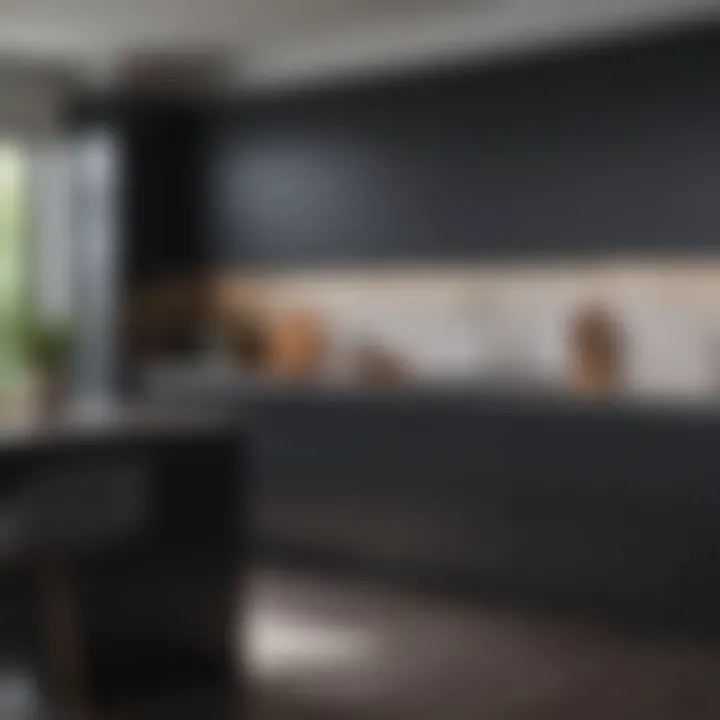
Intro
Dark cabinets have emerged as a favored choice in modern interior design. Their versatility allows them to complement various styles while adding a touch of sophistication. As homeowners and designers seek to create unique spaces, dark cabinetry stands out not just for its aesthetic appeal but also for its practical benefits. This guide delves into the intricacies of dark cabinets, examining materials, finishes, and more, to provide meaningful insights into integrating them into your home.
Interior Design Tips
When considering dark cabinetry, several key aspects come into play, from selecting the right materials to planning the overall design. Here we highlight effective strategies that appeal to homeowners and design enthusiasts alike.
Trendy Design Ideas
The popularity of dark cabinets has given rise to numerous design trends. One notable idea is the inclusion of contrasting colors in the kitchen or bathroom. For example, pairing dark navy cabinets with crisp white countertops creates a striking visual impact. Additionally, integrating wooden accents can soften the overall look.
Another trend involves using a matte finish for dark cabinetry, which can provide a modern yet subtle appeal. Shaker-style doors in a deep charcoal finish are particularly sought after for their timeless allure.
Color Schemes and Combinations
Selecting the right color palette is essential when working with dark cabinets. Neutral tones often work best as companions. Shades of gray, beige, or even soft pastels can create a balanced environment.
Moreover, incorporating metallic hardware adds a layer of elegance. Brass or brushed nickel handles can contrast beautifully with dark surfaces and draw attention in a subtle way.
Furniture Arrangement Techniques
Furniture arrangement is critical for maintaining functionality while accentuating dark cabinetry. Open shelving can enhance visibility and create an open feel, allowing light to bounce around the room. Consider floating shelves positioned above dark cabinets to showcase decorative items or plants.
Maintaining clear pathways is also vital. Ensure that the arrangement does not overshadow the cabinets but rather highlights their beauty.
"The key to successfully incorporating dark cabinets lies in balancing them with the surrounding elements."
Inspirational Home Decor
When it comes to home decor, the contextual usage of dark cabinets can be formidable. Here are some considerations.
Stylish Home Decor Pieces
Integrating artwork or decor pieces can bring vibrancy to a space dominated by dark cabinetry. Look for items that feature lighter tones or vibrant colors to create a focal point. Large abstract paintings can serve as eye-catching accents above dark cabinets.
Wall Art and Prints
Wall art can define the mood and style of your home. Consider photographs or prints framed in lighter woods or metals. This contrast elevates the space, making dark cabinetry feel more inviting.
Lighting and Ambiance
Lighting is another crucial aspect. Focus on warm lighting options that complement dark cabinets. Pendant lights with soft bulbs can create a cozy setting. Incorporating under-cabinet lighting not only adds a practical element but also highlights the beauty of the cabinetry.
Prolusion to Dark Cabinets
Dark cabinets have gained increasing relevance in interior design, particularly for those aiming to curate a modern and sophisticated ambience in their spaces. Understanding the essence of dark cabinets lays the foundation for appreciating their aesthetic and functional merits. They are not merely storage solutions; they serve as integral elements that harmonize with the overall design scheme, influencing mood and atmosphere.
Defining Dark Cabinets
Dark cabinets encompass a range of cabinetry finished in deep hues, such as black, navy blue, deep brown, or charcoal. These colors can impart a sense of richness and elegance to any room. Dark cabinetry is often made from various materials, including solid wood, engineered wood, and sometimes even metal. Each material can achieve distinctive visual and tactile qualities, allowing homeowners to select choices that reflect their style and preferences.
Consider the versatility that dark cabinets offer. They can complement various interior styles, from contemporary to traditional, making them an attractive option for many. Dark cabinets can convey different vibes depending on their placement and surroundings; they can appear both cozy and dramatic, depending on the light conditions and accompanying decor.
Historical Context
The use of dark cabinetry is not a recent trend. Historically, darker woods were favored in many cultures for their durability and aesthetic appeal. For instance, during the Renaissance period, mahogany and walnut were prized for their deep tones and intricate detailing, often seen in grand homes and public buildings. As design philosophies evolved, so did the approach to utilizing dark cabinetry in spaces.
In the latter half of the 20th century, the open-concept layout began to emphasize expansive visual connections between rooms. This shift often called for cabinetry that could stand out yet blend with various elements in a home. Dark cabinets became a popular choice, as they provided contrast without overwhelming the overall design. Now, they are regarded as staples in modern kitchen and bathroom designs, showcasing how historical appreciation for darker woods looped back into the current trend.
Those exploring the depths of dark cabinets should recognize their significance through various lenses: aesthetics, functionality, and historical context. This understanding prepares one to make informed choices when incorporating dark cabinets into their spaces.
Aesthetic Appeal of Dark Cabinets
Dark cabinets have a unique ability to transform spaces, offering a striking visual depth that is increasingly sought-after in modern design. Their aesthetic appeal lies not just in their color but in the way they interact with surrounding elements. Homeowners and interior design enthusiasts often gravitate towards dark cabinetry due to its versatility and sophisticated presence. The rich hues create a moody atmosphere, enhancing the overall elegance of a room.
The importance of the aesthetic appeal of dark cabinets cannot be overstated. They can serve as a stunning focal point or a subtle foundation for other colors and textures to shine. This section discusses the specific elements contributing to this appeal, such as visual impact and color theory, providing a comprehensive understanding of how dark cabinets influence interior design.


Visual Impact
The visual impact of dark cabinets is profound. Their ability to absorb light can create an intimate setting. Whether used in kitchens, bathrooms, or living areas, they can elevate the room's overall design. Dark cabinets provide a striking contrast to lighter elements, enhancing the spatial dynamics. When paired with light countertops or bright wall colors, they create a balanced look that appeals to the eye.
- Contrast and Balance: Dark cabinets can enhance other features in the room, such as artwork or decorative lighting.
- Modern Aesthetic: They are often associated with contemporary and minimalist styles, adding a sleek touch to any space.
- Timeless Elegance: Dark colors never go out of style, making them a lasting choice for home decor.
In addition to these aspects, dark cabinets can also make smaller spaces feel cozier. Their presence suggests warmth and invite comfort while still maintaining a sense of refined sophistication.
Color Theory and Emotions
Color theory plays a significant role in how dark cabinets affect the emotions and perceptions of a space. Dark tones, like navy blue and deep brown, are known to evoke feelings of stability and strength. They can make a room feel more secure. This is particularly appealing in home environments where comfort is essential. Understanding color emotions is crucial for making thoughtful design choices.
- Psychological Effects: Dark colors can evoke calmness, serenity, or even introspection, making spaces feel safe and inviting.
- Accent Color Coordination: When paired with complementary hues, such as golds or whites, dark cabinets can create a luxurious and compelling atmosphere.
Mood plays a substantial role in interior design, and selecting dark cabinetry can significantly influence how a space feels. Homeowners often notice an increase in overall satisfaction with their environments when these design principles are applied thoughtfully.
"The right combination of colors can define a space's character and emotional resonance."
Materials Used in Dark Cabinets
The selection of materials for dark cabinets is crucial in determining not just their aesthetic appeal, but also their functionality and durability. Different materials bring distinct benefits and characteristics to the table, making it essential for homeowners and designers to understand these options. By using the right materials, one can enhance the overall quality and longevity of dark cabinetry, ensuring it remains a wise investment in your interior design.
Wood Options
When discussing dark cabinets, hardwood is often the first consideration. Species such as walnut, oak, and cherry offer rich colors and varied grain patterns that can elevate the visual interest of cabinetry. The natural properties of wood provide durability and strength, making it a favored choice for kitchen accessories or storage solutions.
Additionally, solid wood cabinets can be refinished when worn, extending their lifespan considerably. However, they can be susceptible to moisture and temperature changes, which could lead to expansion or contraction. This requires careful maintenance and environment control to prevent damage.
Some other woods can include softer options like pine, often treated with stains or finishes to achieve a darker hue while maintaining lower costs. The choice of wood can significantly affect the overall ambiance.
Engineered Materials
Engineered materials, such as MDF and plywood, are becoming increasingly popular for dark cabinetry. Medium Density Fiberboard (MDF) is particularly notable for its smooth surface which is ideal for painting. It does not warp easily and is less costly compared to solid wood. However, it is not as durable in high-moisture environments.
Plywood, on the other hand, adds robustness due to its layered construction. It holds up well against changes in humidity and temperature. Many designers choose birch or maple plywood for a clean aesthetic that can be stained or painted in darker finishes to achieve the desired dark cabinet effect.
Adopting engineered materials can represent a balance between quality and affordability, appealing to budget-conscious homeowners while not sacrificing style.
Paint Finishes
Paint finishes play an essential role in the overall look and feel of dark cabinets. High-gloss finishes can create a modern and sleek appearance, reflecting light and enhancing the sense of space. Satin or matte finishes, on the other hand, impart a sense of subtlety and depth.
Choosing the right type of paint is equally important. Acrylic and enamel are popular options for their durability and ease of cleaning. While they offer a beautiful finish, they vary in terms of resistance to chipping and fading, factors that should be considered when selecting finishes for high-use areas like kitchens.
One viable strategy is to apply a combination of finishes. For example, one could use a matte finish on cabinet doors while opting for high-gloss on hardware or trim, creating a visual contrast that stands out.
Consider how different materials not only contribute to aesthetics but also influence functionality in daily use.
Functionality of Dark Cabinets
Understanding the functionality of dark cabinets goes beyond the aesthetics; it is about enhancing everyday living. These elements serve practical purposes while contributing to the overall design scheme of a space. Homeowners and interior design enthusiasts should consider how dark cabinetry can streamline organization, improve durability, and adapt to various needs in their homes.
Storage Solutions
Dark cabinets offer a significant advantage in storage. Their design allows for maximum utilization, making them a staple in kitchens and other areas needing organization. Here are a few key points to consider regarding storage solutions:
- Versatile Storage Options: Dark cabinets provide ample space for household items. They can be tailored with shelving, drawers, or pull-outs. Customization options allow homeowners to select features that best suit their needs.
- Visibility and Access: The depth and layout of these cabinets can improve access to stored items. Utilizing full-extension drawers or lazy Susans enhances visibility, preventing the common problem of forgotten items at the back of the shelves.
- Color Contrast: Dark cabinetry can be paired with lighter elements to create contrast. This balance can highlight space while also making it easier to find items at a glance.
"Dark cabinetry can revolutionize organization strategies in your kitchen and beyond. Their adaptability makes them essential for functionality in modern homes."
Durability Considerations
Durability is a vital aspect when choosing dark cabinets. Homeowners must consider how well their cabinetry can withstand wear and tear over time. Here are some factors to explore:
- Material Strength: The choice of materials impacts durability. For instance, solid hardwood like oak or maple tends to last longer than softer woods. Engineered materials can also offer impressive resilience.
- Finish Quality: The finish applied to dark cabinets not only impacts appearance but also protection. High-quality finishes defend against scratches, stains, and moisture, helping maintain the cabinet's appearance over time.
- Hardware Selection: Choosing the right hardware can enhance both functionality and lifespan. Sturdy hinges and robust handles are essential components that can significantly influence overall durability.
By focusing on storage and durability, dark cabinets prove to be more than just a design choice; they provide essential functionality that enriches daily life within the home.
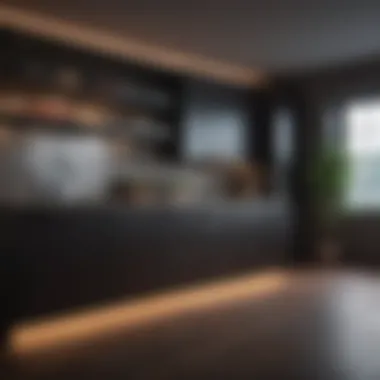
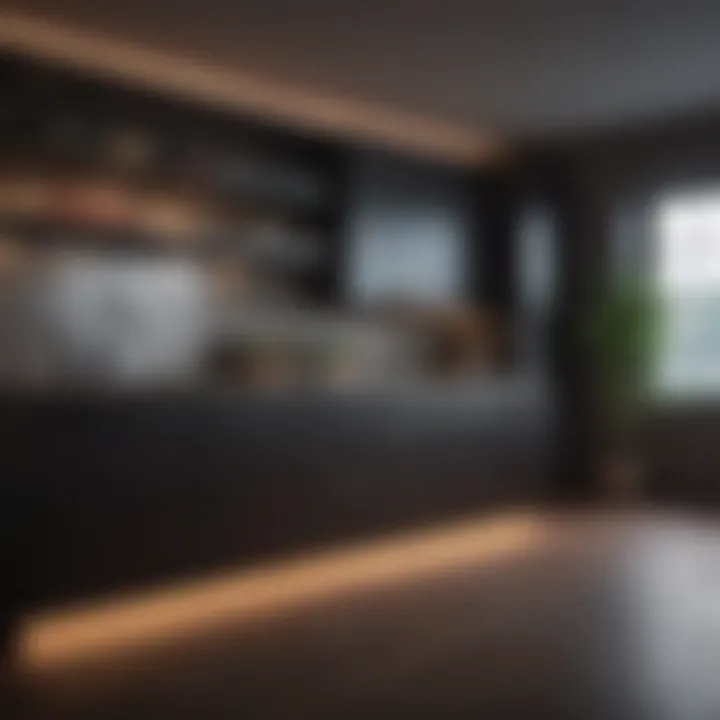
Design Considerations
Design considerations are vital in the context of dark cabinets because they dictate not only the visual impact but also the functionality of any space. Dark cabinets can enrich a room's aesthetic while providing practical uses, but this balance requires thoughtful planning. Failing to consider these elements might lead to an overwhelming atmosphere or underwhelming utility. Homeowners and designers alike must weigh aspects such as lighting, color coordination, and overall layout to create a harmonious environment.
Balancing Light and Dark
Achieving balance between light and dark in interior design is essential, particularly when using dark cabinets. Light can either complement or clash with dark tones. A well-considered approach involves strategically placing light sources to enhance the cabinets' elegance. Natural light can help in this regard, so consider using large windows or light-filtering curtains. Moreover, artificial lighting plays a crucial role. Options such as recessed lighting or under-cabinet LED strips can create an inviting glow around the dark surfaces, softening their impact.
In addition, the surrounding color palette should include lighter shades. This can be achieved through paint, wall art, or even decorative accessories. Lighter tones work to visually lift the space, counteracting any heaviness that dark cabinets might introduce. Here are some tips to help balance light and dark effectively:
- Choose wall colors that are soft and light to contrast the darkness.
- Incorporate varying textures to add depth, such as mixing sleek surfaces with more rustic elements.
- Use mirrors strategically to reflect light and make spaces appear larger.
"Balancing light and dark can lead to an atmosphere that feels cohesive and well-planned."
Coordinating with Other Elements
Coordinating dark cabinets with other design elements in a space is crucial for maintaining a unified look. It is not just about the color of the cabinets, but how they relate to furniture, flooring, and accents. For instance, pairing dark cabinets with lighter countertops and backsplash can create a desirable contrast. Additionally, metals and finishes should be harmonious. If the cabinets are matte black, consider using brushed nickel or gold fixtures to enhance overall coherence.
Textures should also be considered in these combinations. For example, placing dark cabinets next to natural wood finishes or textiles can create a multidimensional effect, preventing the space from feeling monochromatic.
Here are some practical steps to effectively coordinate dark cabinets with other elements:
- Evaluate the overall style of the room to ensure all elements complement each other.
- Mix materials intentionally; combine dark cabinets with woven or metallic accents for visual interest.
- Consider the scale of items in the space, maintaining a balance between oversized and delicate objects.
Effective coordination can lead to an interior that feels thoughtfully curated, elevating the purpose and appeal of dark cabinetry in any living space.
Dark Cabinets in Various Settings
Dark cabinets have a significant impact in many living spaces. Their versatility allows them to shine, whether in kitchens, bathrooms, or living areas. The selection of a dark cabinet influences the overall atmosphere and functionality of the space.
Kitchens
In the kitchen, dark cabinets can be a bold statement. They create a dramatic contrast when paired with lighter countertops and backsplash options. This color scheme adds depth to the room. Dark cabinets are often seen as more modern and sleek. A kitchen with dark cabinetry can appear sophisticated and elegant.
Benefits include:
- Enhanced visual interest
- An ability to hide fingerprints or stains than lighter colors
- The option to introduce varied textures that complement darker hues, such as brushed metal or light wood
Moreover, the use of dark cabinets allows for dynamic lighting designs. Under-cabinet lighting can enhance the elegance of dark finishes, effectively illuminating the workspace while creating an inviting ambiance. The interplay between light and dark is essential for achieving functionality while still preserving aesthetic appeal.
Bathrooms
Dark cabinets in bathrooms present a unique charm. They can evoke a sense of luxury and relaxation, making the bathroom a personal retreat. When paired with bright, white tiles or vibrant accents, dark cabinets can create a strikingly elegant space.
Key considerations include:
- Maintaining good lighting to avoid a dim or cramped feeling
- Choosing materials that resist moisture and are easy to clean
- The flexibility to integrate sophisticated accessories that enhance the dark cabinetry, like gold hardware or sleek faucets
The cabinet choice may also impact storage solutions. Dark vanities with ample storage can declutter small bathrooms, making them feel more spacious. Effective organization strategies ensure that functionality is not sacrificed for aesthetics in these intimate spaces.
Living Areas
In living areas, dark cabinets can anchor a space visually. They often serve as a foundation for other design elements, such as furniture and decor. Dark cabinetry can harmonize with various styles, from contemporary to traditional. This adaptability signifies their importance.
Benefits include:
- A solid back drop for brighter furnishings
- The ability to create cozy, inviting atmospheres when combined with softer textiles
- Customization options, including built-ins or open shelving, that maintain a visually appealing arrangement
Dark cabinets allow homeowners to strike a balance between function and form in their living areas. They not only provide storage but also act as a canvas for personal expression through curated displays and decorative items.
"Dark cabinets bring character and depth to a room. The right setting can transform an ordinary space into something striking."
Maintenance of Dark Cabinets
Maintaining dark cabinets is essential for preserving their aesthetic appeal and functionality. This section elaborates on the necessary practices to keep cabinets looking their best while ensuring their longevity. Dark cabinetry possesses a unique charm, but it can also be prone to showing dust, fingerprints, and scratches more readily than lighter surfaces. Proper maintenance strategies can reduce these issues significantly.
Cleaning Strategies
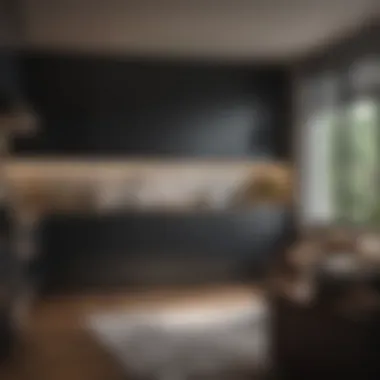
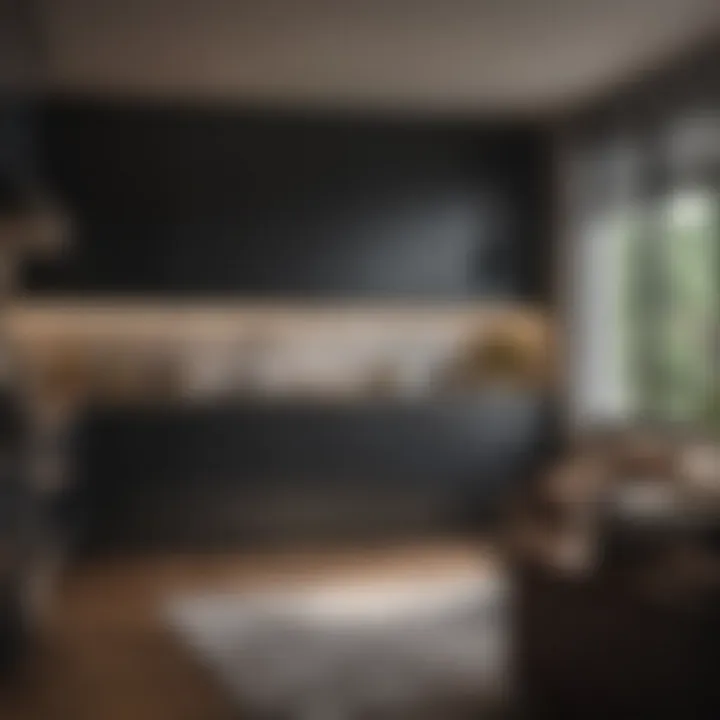
Regular cleaning is vital for dark cabinets. The right cleaning solutions and techniques can prevent dullness while ensuring the surface remains smooth. Here are some effective cleaning strategies:
- Microfiber Cloths: Using a soft microfiber cloth for daily dusting is advisable. This can cut down residue buildup without scratching surfaces.
- Gentle Cleaners: Opt for gentle, pH-balanced cleaning solutions specifically designed for wood products. Avoid harsh chemicals, as they can degrade the finish over time.
- Spot Cleaning: In case of spills or stains, address them immediately. Blot the area with a damp cloth, then dry thoroughly to avoid water damage.
- Routine Care: Develop a routine schedule for thorough cleaning. Wipe down cabinets at least once a week to decrease buildup of grime.
Preventing Scratches and Wear
In addition to cleaning, preventative measures are crucial in maintaining the integrity of dark cabinets. Scratches and wear often arise due to everyday usage, but specific strategies can mitigate this:
- Use Protective Pads: Place felt pads under items such as vases, appliances, or any object that frequently touches the cabinet surface. This reduces friction and minimizes scratches.
- Careful Handling: Handle doors and drawers gently. Avoid slamming, as this can lead to structural damage over time.
- Avoid Sharp Objects: Never drag sharp objects across the cabinet surface, as this can create deep scratches.
- Regular Inspections: Keep an eye out for wear and identify potential problem areas. Early detection of issues can make repair simpler and more effective.
Important Note: Regular maintenance not only enhances the appearance of dark cabinets but also conserves their value.
In summary, maintaining dark cabinets involves a mix of effective cleaning strategies and preventive care measures. By following these guidelines, homeowners can ensure their dark cabinetry remains an attractive centerpiece in their interior spaces.
Trends in Dark Cabinetry
The trends in dark cabinetry play a pivotal role in shaping modern design aesthetics and functionality. In the last few years, the popularity of dark cabinets has surged, as they offer a bold choice in various interior spaces. This shift reflects a move toward more sophisticated and dramatic looks that surpasses traditional lighter shades. Homeowners and designers alike are increasingly drawn to the versatility of dark cabinetry, recognizing it as both a style statement and a practical choice.
Popular Design Styles
Some popular design styles using dark cabinets include:
- Modern Minimalism: In this style, dark cabinets are paired with clean lines and uncluttered spaces, creating a sleek and contemporary atmosphere.
- Industrial Chic: Dark wood or metal finishes complement raw materials, such as exposed bricks and concrete. This industrial style enhances the overall edginess of the space.
- Rustic Elegance: Here, dark cabinets combined with natural elements, like wood beams or stone, create warmth and comfort.
- Traditional Sophistication: Dark wood finishes, intricate moldings, and classical elements form a refined appearance indicative of classic design.
Each of these styles highlights the range of options available for integrating dark cabinetry, showing its capability to enhance various decor themes while maintaining a cohesive flow within the space.
Color Innovations
Color innovations in dark cabinetry continue to evolve, providing homeowners with fresh options to personalize their living spaces. The trend is moving away from uniform dark hues towards richer, layered color palettes. Various shades of navy, forest green, and deep charcoal offer distinct personalities, breaking the monotony that often accompanies dark cabinetry.
Additionally, the use of mixed materials and finishes allows for a more personalized touch. Cabinetry may now feature matte finishes, glossy accents, or even textural alternatives such as reclaimed wood with dark stains.
"The choice of color combined with texture can dramatically influence how dark cabinetry fits within the broader design context."
As these trends continue to develop, it is evident that dark cabinetry is not merely a passing fad but a staple in modern design, encouraging creativity and innovation ranging from color selection to material combinations.
Case Studies
The exploration of dark cabinets can greatly benefit from examining case studies. These real-world examples illustrate both the practical applications and emotional impacts of integrating dark cabinetry into home spaces. Case studies provide deeper insight into design strategies, helping to identify trends and successful implementations.
Within this article, case studies demonstrate how various homeowners approached dark cabinets. By analyzing different settings, we can reveal common challenges and innovative solutions. These case studies serve as a guide, emphasizing the ways dark cabinets can enhance functionality and aesthetics in diverse environments.
Successful Incorporation
Successful incorporation of dark cabinets often comes down to understanding the specific needs of a space. Homeowners have leveraged dark cabinetry in kitchens, bathrooms, and living areas. Each case varies in design and function yet shows a clear commitment to creating a harmonious environment.
For instance, in a modern kitchen, some homeowners combined dark cabinets with light-colored countertops and backsplashes. This contrast not only makes cabinets stand out but also brightens the overall space. In a bathroom setting, dark cabinetry brought elegance while providing plenty of storage. Designers focused on balance to avoid overwhelming the area with darkness.
Key considerations for successful incorporation include:
- Lighting: Proper lighting can enhance cabinet features, preventing them from making rooms appear smaller.
- Color Pairing: Selected colors should complement the dark tones, creating visual balance.
- Material Choice: Selecting materials that suit the room's function is crucial.
Lessons Learned
Case studies reveal valuable lessons about dark cabinets in interior design. One significant lesson is the need for thorough planning before installation. Mistakes in measurements or color choices can lead to costly redesigns. Furthermore, understanding the maintenance required for different materials is essential for long-term satisfaction.
Another lesson is the importance of keeping the overall design cohesive. Successful spaces often reflect a clear design vision that integrates dark cabinets seamlessly. Homeowners should avoid unnecessary elements that clash with the tones of dark cabinetry.
The insights from these case studies emphasize:
- Planning is Key: Careful consideration of space and materials can avoid future regrets.
- Cohesion Matters: A well-thought-out design ensures all elements contribute to the intended feel of the space.
- Right Lighting Choices: Proper lighting choices go a long way in enhancing dark cabinets' beauty while ensuring functionality.
End
The conclusion of this article encapsulates the multi-dimensional aspects of dark cabinets. These elements not only enhance the visual appeal of various spaces but also offer substantial practical benefits. Dark cabinetry can create a striking aesthetic when properly integrated with lighting and color schemes. Further, it emphasizes sophistication while providing essential storage solutions suitable for modern life.
Final Thoughts
In light of the numerous considerations covered throughout this guide, it is clear that dark cabinets serve a dual purpose that blends aesthetics with functionality. Their popularity continues to rise, influenced by changing design trends and consumer preferences. Homeowners must think critically about their space, envisioning how dark cabinets fit into their overall plan. Making informed choices leads to a space that not only meets needs but also fosters an engaging atmosphere.
Future Prospects
Looking ahead, the future of dark cabinetry is promising. Innovations in materials and finishes will continue to emerge, offering even greater versatility and sustainability. Consumers may expect to see dark cabinets paired with adaptive technologies, enhancing utility in ways yet to be realized. As interior design evolves, dark cabinetry will likely remain a cornerstone, adapting to new styles while preserving its core allure. Interior designers should keep an eye on these trends, as understanding them will be key to maintaining relevance and allure in the ever-fluid world of design.







